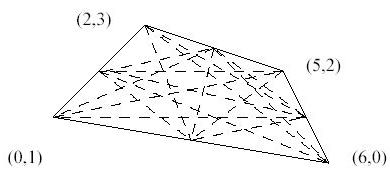 |
| ||||
Home Page
F.A.Qs
Statistical Charts
Past Contests
Scheduled Contests
Award Contest
| ||||||||||
| Online Judge | Problem Set | Authors | Online Contests | User | ||||||
|---|---|---|---|---|---|---|---|---|---|---|
| Web Board Home Page F.A.Qs Statistical Charts | Current Contest Past Contests Scheduled Contests Award Contest | |||||||||
|
Language: This Takes the Cake
Description In the kingdom of Polygonia the royal family consists of the king, the queen, and the 10-year-old twins,Prince Obtuse and Prince Trisect. The twins are fiercely competitive, and on their birthday they always vie with each other for the biggest portion of the cake. The wise king and queen have devised the following way to prevent squabbles over the cake. One prince is allowed to cut the cake into two pieces, then the other prince gets to choose which of the two pieces he wants.
Cakes in Polygonia are always in the shape of a convex quadrilateral (a four-sided polygon with each internal angle less than 180 degrees). Furthermore, local custom dictates that all cake cutting must be done using a straight cut that joins two vertices, or two midpoints of the sides of the cake, or a vertex and a midpoint. For instance, the following figure shows all the possible legal cuts in a typical cake.  Your problem is to determine, for a number of different cakes, the best cut, i.e., the one that divides the cake into two pieces whose areas (we are disregarding the thickness of the cake) are as nearly equal as possible. For instance, given a cake whose vertices (when the cake is viewed from above) are located, in counterclockwise order, at the points (0, 1), (6, 0), (5, 2) and (2, 3), the best possible cut would divide the cake into two pieces, one with area 4.375, the other with area 5.125; the cut joins the points (1, 2) and (5,5,1) (the midpoints of two of the sides). Input Input consists of a sequence of test cases, each consisting of four (x, y) values giving the counterclockwise traversal of the cake's vertices as viewed from directly above the cake; the final test case is followed by a line containing eight zeros. No three points will be collinear, all quadrilaterals are convex, and all coordinates will have absolute values of 10000 or less. Output For each cake, the cake number followed by the two areas, smaller first, to three decimal places of precision. Sample Input 0 1 6 0 5 2 2 3 0 0 100 0 100 100 0 100 0 0 0 0 0 0 0 0 Sample Output Cake 1: 4.375 5.125 Cake 2: 5000.000 5000.000 Source |
[Submit] [Go Back] [Status] [Discuss]
All Rights Reserved 2003-2013 Ying Fuchen,Xu Pengcheng,Xie Di
Any problem, Please Contact Administrator